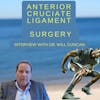
Mastering Medical Knowledge with the Rule of Threes: A Study Technique for Improved Learning and Recall


How I became a Surgeon : Knowing 3 things.
Ever felt like you're drowning in information, struggling to keep your head above the vast ocean of facts and details? You're not alone. Join me, Dr Gavin Nimon an orthopaedic surgeon and your guide through the unfathomable depths of medical knowledge on Aussie MedEd.
In this episode, I reveal the Rule of Threes, a study technique that transformed my approach to learning and retaining complex medical information. It's not just another mnemonic; it's a powerful concept borrowed from storytelling that can help you, regardless of your field, navigate through the thicket of facts to the clearings of understanding.
We'll discuss the limitations of traditional acronyms and how visualizing patient presentations in threes can sharpen your recall and deepen your responses. As I walk you through this principle, you'll see how dividing information into triadic components not only simplifies your studies but also enriches your grasp of any subject.
This isn't about a one-size-fits-all method but an invitation to reframe your learning process, potentially turning the tide in your educational journey. So whether you're a student wrestling with textbooks or a seasoned professional looking to stay on top of your game, tune in and explore how the Rule of Threes could anchor your learning strategies.
Aussie Med Ed is sponsored by OPC Health, an Australian supplier of prosthetics, orthotics, clinic equipment, compression garments, and more. Rehabilitation devices for doctors, physiotherapists, orthotists, podiatrists, and hand therapists. If you'd like to know what OPC Health offers.
Visit opchealth. com. au and view their range online.
00:00:00.000 --> 00:00:02.620
A student once asked me, how do you remember everything in medicine?
00:00:02.709 --> 00:00:05.530
How can you possibly learn it all and keep track of everything you need to know?
00:00:06.080 --> 00:00:08.699
There's so much to learn, there's so much to do and see.
00:00:08.699 --> 00:00:10.614
Visit How can you possibly do it all?
00:00:11.275 --> 00:00:12.444
Well, medicine is difficult.
00:00:12.494 --> 00:00:16.015
It's hard to remember things, but you've got to work out a technique that works for yourself.
00:00:17.044 --> 00:00:19.814
Today we're going to discuss a technique that I used going through many years ago.
00:00:20.535 --> 00:00:24.625
It's a way of dividing things up into simple little aliquots of information to help me remember things.
00:00:25.053 --> 00:00:26.524
It's called the rule of threes.
00:00:27.035 --> 00:00:29.024
G'day, and welcome to Aussie Med Ed.
00:00:31.144 --> 00:00:38.823
G'day and welcome to Aussie Med Ed, the Australian medical education podcast designed with a pragmatic approach to medical conditions by interviewing specialists in the medical field.
00:00:39.424 --> 00:00:49.914
I'm Gavin Nimon, an orthopaedic surgeon based in Adelaide and I'm broadcasting from Kaurna Land I'd like to remind you that this podcast is available on all podcast players and is also available as a video version on YouTube.
00:00:50.585 --> 00:00:57.743
I'd also like to remind you that if you enjoy this podcast, please subscribe or leave a review or give us a thumbs up as I really appreciate the support and it helps the channel grow.
00:00:58.420 --> 00:01:06.939
I'd like to start the podcast by acknowledging the traditional owners of the land on which this podcast is produced, the Kaurna people, and pay my respects to the Elders both past, present and emerging.
00:01:11.659 --> 00:01:13.000
G'day and welcome to Aussie Med Ed.
00:01:13.409 --> 00:01:18.524
Today we're going to talk about a study technique, one that relies on a simple pattern using the rule of threes.
00:01:19.245 --> 00:01:23.444
It's a method I use going through medicine, and one that I tend to use in teaching orthopaedics.
00:01:23.954 --> 00:01:28.935
I'll start off by saying that it's only one method, and one that works for me, but it may not be suitable for everyone.
00:01:29.275 --> 00:01:31.334
This method can be used for any study or learning technique.
00:01:31.545 --> 00:01:34.665
But obviously my area is medicine, and that's what I'm applying to it today.
00:01:35.355 --> 00:01:36.903
Now there are methods of learning medicine.
00:01:37.313 --> 00:01:40.754
One technique that many of my colleagues would use was using acronyms.
00:01:41.135 --> 00:01:43.844
This is where a letter of a word is used to spell out a list.
00:01:44.215 --> 00:01:46.355
Often the acronym might involve a catchy phrase.
00:01:46.953 --> 00:01:50.603
Despite having an amazing musical type memory, I always found these very difficult to remember.
00:01:50.614 --> 00:01:52.694
I also found them not that relevant.
00:01:53.215 --> 00:02:00.474
The classic one that I always did remember was vitamin D, as a way of recalling a generalised list and attempting to provide a differential diagnosis for a condition.
00:02:01.204 --> 00:02:04.965
The clinician might have asked me, so Gavin, what's the differential diagnosis for chest pain?
00:02:05.525 --> 00:02:09.615
I never found that recalling vascular, inflammatory, traumatic, etc.
00:02:09.844 --> 00:02:10.704
was all that helpful.
00:02:11.085 --> 00:02:15.324
Whilst it produces a list, often it starts with quite rare conditions and the list always seems quite haphazard.
00:02:15.954 --> 00:02:19.155
On top of this, the numerous lists of acronyms were always difficult to recall.
00:02:19.514 --> 00:02:25.204
My approach to this was going down a very keep it simple approach, breaking up diagnoses into how patients might present.
00:02:25.674 --> 00:02:28.254
That is, picturing how I might come across the patients with a condition.
00:02:28.814 --> 00:02:32.174
This involves dividing into small divisions which builds upon themselves.
00:02:32.969 --> 00:02:36.150
I always did this for many years, but I didn't realise this technique had a name.
00:02:36.968 --> 00:02:39.558
Years ago, my daughter asked me to check an English essay.
00:02:40.039 --> 00:02:47.250
I came across obvious metaphors and similes which she discussed, which I all knew about, but then I noted that she had classified one part of her essay into the rule of threes.
00:02:47.469 --> 00:02:48.718
I didn't even know what this was.
00:02:49.129 --> 00:02:52.729
I went and looked it up and thought, God, that's the technique that I've been using all my life.
00:02:53.400 --> 00:03:00.479
I realised my technique, which involved learning small subsets using a very simple approach, had a name, and that's called the Rule of Threes.
00:03:01.139 --> 00:03:04.939
This approach of learning less helps you learn more, in my mind.
00:03:05.219 --> 00:03:06.240
But what is this Rule of Threes?
00:03:06.240 --> 00:03:07.060
What does it involve?
00:03:07.490 --> 00:03:09.610
The concept of Rule of Threes is a writing principle.
00:03:09.750 --> 00:03:13.229
It's actually one where you divide things up into three subsets of information.
00:03:13.719 --> 00:03:19.870
In doing this, it helps you recall information, and when answering a question, offering three options, that gives you some substance to your answer.
00:03:20.770 --> 00:03:23.030
It's probably something you've been exposed to throughout your life.
00:03:23.215 --> 00:03:31.715
You might have heard nursery rhymes or children's stories involving it, the three blind mice, Goldilocks and the three bears, the story of the three little pigs.
00:03:32.444 --> 00:03:36.895
Popular music often involves three chords or has three divisions, verse, chorus and bridge.
00:03:37.224 --> 00:03:40.344
And of course, famous speeches also often involve just three words.
00:03:40.664 --> 00:03:43.034
Julius Caesar, I came, I saw, I conquered.
00:03:43.525 --> 00:03:48.254
And also when you talk about location, you know, in property market, location, location, location.
00:03:49.025 --> 00:03:53.264
Even in social life, how often do you go out with two other friends, making up a group of three?
00:03:53.903 --> 00:04:02.115
And when you're going for job interviews, a structured answer to the question of what your goals are in life sounds so much better when answering about your short, intermediate and long term goals.
00:04:02.729 --> 00:04:09.879
In the same way, when offering advice, or if someone asks you, what do you think the options are, thinking of the three things sounds so much better, they just roll off the tongue.
00:04:10.319 --> 00:04:15.399
When you try to think of anything further, it makes it hard, and if you only offer one or two options, it doesn't look quite as impressive.
00:04:16.468 --> 00:04:18.769
In medicine, diagnosis is the key.
00:04:19.120 --> 00:04:21.048
The diagnosis is what dictates treatment.
00:04:21.500 --> 00:04:23.668
The role of assessing a patient is to determine diagnosis.
00:04:25.029 --> 00:04:30.339
Diagnosis is formed by taking a history, performing an examination, and then undertaking investigations.
00:04:30.850 --> 00:04:31.660
Three things again.
00:04:33.490 --> 00:04:35.889
History is predominantly what helps you make the diagnosis.
00:04:36.774 --> 00:04:37.725
It's the most valuable.
00:04:38.694 --> 00:04:48.944
Examination helps you confirm the diagnosis, while the investigations again help you back up the diagnosis, but help you stage your conditions, determine treatment options and determine prognosis.
00:04:49.184 --> 00:04:57.838
Investigations then also help you further confirm the diagnosis, but also assist you in staging the condition, one, determine treatment options two, and determine prognosis three.
00:04:58.709 --> 00:05:02.629
Now whilst I would always start by stating that in medicine you don't need to know everything.
00:05:03.139 --> 00:05:05.298
We need to know most common and serious conditions.
00:05:05.740 --> 00:05:07.288
But often we have the advantage of time.
00:05:07.298 --> 00:05:10.370
In what I call, who wants to be the millionaire approach.
00:05:10.889 --> 00:05:13.089
If you don't know the answer you can always phone a friend.
00:05:13.180 --> 00:05:15.500
That's when you get a specialist opinion or consult someone.
00:05:16.720 --> 00:05:18.839
You might, you might need to ask the audience.
00:05:19.180 --> 00:05:22.389
I, therefore you present the scenario at a grand round, two.
00:05:22.819 --> 00:05:24.889
Or you may need to come back and play the next day.
00:05:25.228 --> 00:05:26.428
See the patient back again.
00:05:26.699 --> 00:05:30.069
After you've had, this is after you've had time to research the diagnosis, three.
00:05:31.370 --> 00:05:32.860
So really medicine can be quite simple.
00:05:33.000 --> 00:05:35.730
If you keep getting into this sort of rule of threes it makes it even easier.
00:05:35.949 --> 00:05:40.649
The most and best way of being safe and effective doctor is by learning the more common things and then expanding upon it.
00:05:41.110 --> 00:05:43.319
This will help you learn medicine in a very effective way.
00:05:44.309 --> 00:05:52.459
Returning to the rule of threes has benefits in that dividing things up into three helps memory retention by combining brevity and rhythm to combine into a creative pattern.
00:05:53.410 --> 00:05:56.738
Now I can hear you say, do we really divide everything up into threes?
00:05:56.738 --> 00:05:57.610
Does it always work?
00:05:57.629 --> 00:06:08.189
Well, if you think of a three as the most common And you think of a Gaussian distribution of numbers, the bell curve, if 3 is the most common number, then I think we can stretch the scenario to occasionally incorporate the rule of 4s.
00:06:08.949 --> 00:06:13.509
So you might say to me, okay, that's all very good, but how is this useful for learning the whole of medicine?
00:06:13.658 --> 00:06:24.535
Well again, when I'm assessing a patient, I'm trying to form a diagnosis, and unless you know all the possible common diagnoses, The way I can remember what conditions can occur is by thinking about how the patient might present.
00:06:25.194 --> 00:06:27.194
They usually can present in one of three ways.
00:06:27.223 --> 00:06:36.293
They can present in an emergency scenario, traumatic condition, or an elective scenario to a clinic, or as a mixed picture, something that comes in through casually but then becomes more elective.
00:06:36.923 --> 00:06:38.334
And that's my three definitions.
00:06:38.334 --> 00:06:43.324
In my area, with a shoulder condition, traumatic conditions can be one of three options.
00:06:43.944 --> 00:06:46.305
Fractures, dislocations and infections.
00:06:47.079 --> 00:06:56.449
Now you can actually get a fourth option of which involves tendon tears, such as if you get a tear of the rotator cuff, but this often is usually an elective presentation, it usually presents slowly.
00:06:56.839 --> 00:06:58.399
But you can think of three or four conditions.
00:06:58.879 --> 00:07:01.468
In the shoulder, I often say to the student, what can be fractured?
00:07:01.699 --> 00:07:07.845
When I ask a medical student what can be fractured, You often get a bit confused when I pick a bone at random, like a clavicle or a humerus.
00:07:07.845 --> 00:07:11.754
But if you break it down in the shoulder, there are three bones that make up the shoulder.
00:07:12.055 --> 00:07:14.553
The clavicle, proximal humerus and scapula.
00:07:14.935 --> 00:07:16.334
I say then what can be dislocated?
00:07:16.694 --> 00:07:22.223
Well obviously a joint, and the three are sternoclavicular joint, chromioclavicular joint and the glenohumeral joint.
00:07:22.904 --> 00:07:23.954
Now what can be infected?
00:07:24.014 --> 00:07:27.064
Well either the bones, the joints or the soft tissues around it.
00:07:27.964 --> 00:07:30.904
If we consider what can be torn or ruptured, well obviously the tendons.
00:07:31.464 --> 00:07:39.923
And these tendons can be the most common ones of the rotator cuff, of which there are four tendons, the supraspinatus, infraspinatus, subscapularis, and teres minor.
00:07:40.374 --> 00:07:43.944
But in reality, the teres minor doesn't really tear quite as easily as the other three.
00:07:45.069 --> 00:07:50.079
Obviously, you can have a rotator cuff torn, but the other tendon that tears quite commonly is the long headed biceps.
00:07:50.730 --> 00:07:53.569
And again, the third one we should think about is the pectoralis major.
00:07:54.038 --> 00:07:56.100
So again, you've got to get group of three to think about.
00:07:57.358 --> 00:07:59.459
So you can see why knowing anatomy is quite useful.
00:07:59.509 --> 00:08:04.879
And in our course, we actually combine and do a revision of anatomy as a way of trying to help learn medicine and orthopaedics.
00:08:06.329 --> 00:08:08.809
Now, if we look at elective conditions, it's a similar scenario.
00:08:09.288 --> 00:08:14.524
However, the rule of threes doesn't always apply quite as easily when it comes to the elective conditions, as we need to know more about just that.
00:08:14.985 --> 00:08:17.884
More than just the anatomy, more the specific diagnoses.
00:08:18.194 --> 00:08:20.194
But often there are only a few conditions that can occur.
00:08:20.865 --> 00:08:25.014
For instance, when it comes to the shoulder, there's only really about four conditions, effectively.
00:08:25.524 --> 00:08:28.673
Um, and only really three of these relate to the shoulder.
00:08:28.725 --> 00:08:33.644
You've got the rotator cuff spectrum, you've got the frozen shoulder condition, and you've got arthritis.
00:08:33.953 --> 00:08:37.073
The fourth thing that can occur in the shoulder is preferred pain from the neck.
00:08:37.575 --> 00:08:40.985
Now again, looking at the rotator cuff, there are four muscles that make up that rotator cuff.
00:08:41.384 --> 00:08:43.965
Really, there's only three stages of rotator cuff conditions.
00:08:44.794 --> 00:08:50.095
There's the bursitis or tendinopathy, there's rotator cuff tears, and then there's secondary arthritis.
00:08:50.975 --> 00:09:03.565
So in other words, initially the person may present with bursitis and tendinopathy with a painful arc, then they may have similar features with a small rotator cuff tear, but as it gets bigger it can lead to weakness, and then as it gets even bigger again it can lead to secondary arthritis.
00:09:04.254 --> 00:09:07.823
If we think about frozen shoulder, there are actually three main stages of frozen shoulder.
00:09:08.034 --> 00:09:12.664
There's the acute painful stage, then there's the stiff phase, and then there's the thawing phase.
00:09:13.274 --> 00:09:16.934
Again, three type stages of a, of a frozen shoulder condition.
00:09:17.203 --> 00:09:23.563
When it comes to arthritis, I like to think of arthritis as being primary osteoarthritis, one that occurs out of the blue and is related to genetics.
00:09:23.794 --> 00:09:28.624
Secondary, secondary trauma or infection or post rheumatoid conditions or inflammatory arthritis.
00:09:29.644 --> 00:09:35.044
And then you get a inflammatory type conditions, rheumatological conditions, which is a huge number.
00:09:35.554 --> 00:09:38.823
And of course, we can look at that in a separate, separate talk.
00:09:39.164 --> 00:09:42.884
We've already got two very good talks on Aussie Med Ed from Sam Whittle regarding this.
00:09:44.220 --> 00:09:47.580
Finally, if you look at referred pain from the neck, you can divide that up into three aspects too.
00:09:47.580 --> 00:09:50.879
You can either get referred pain, mechanical pain into the scapula.
00:09:51.340 --> 00:09:54.960
You can get neck pain with radiculopathy, secondary to nerve entrapment.
00:09:55.278 --> 00:09:58.700
Or you can get cervical spine pain with actually long track signs of myelopathy.
00:09:59.090 --> 00:10:03.609
Finally, when I'm thinking about causes of shoulder pathology, I've already mentioned traumatic and elective conditions.
00:10:03.909 --> 00:10:07.729
There's also that mixed picture, the third type of presentation.
00:10:07.989 --> 00:10:15.879
In the shoulder, this involves an acute dislocated shoulder becoming elective with recurrent subluxation episodes, secondary to label tears, after the initial acute dislocation.
00:10:17.429 --> 00:10:22.538
Therefore, you can see that by dividing things up into groups of threes, it's a simple way of easily remembering things.
00:10:23.668 --> 00:10:26.899
This rule of threes can also be used when looking at other things, such as complications.
00:10:27.458 --> 00:10:34.159
You think about complications as being divided up into short, intermediate and long term complications, and of course being localised or generalised.
00:10:35.085 --> 00:10:37.164
Rule of threes can also be used for investigations.
00:10:37.684 --> 00:10:45.125
Start off with simple bloods or ECGs, basic radiology, x rays and ultrasounds, or more advanced radiology, CT or MRI.
00:10:45.485 --> 00:10:53.114
When it comes to treatment options, particularly in fractures, you might think of non operative procedures, manipulation under anesthetic and plaster, or surgical fixation.
00:10:53.254 --> 00:10:54.644
Again, three different options.
00:10:55.184 --> 00:10:58.934
So my technique of trying to remember things in a simple approach is to keep it simple.
00:10:59.684 --> 00:11:00.774
Use the rule of threes.
00:11:01.195 --> 00:11:06.235
And by doing this I can honestly say I learnt medicine using only the rule of threes or knowing only three things.
00:11:06.595 --> 00:11:08.835
Albeit it's quite a wide selection of three things.
00:11:09.744 --> 00:11:13.894
Over the next few months I'll look at other conditions and how they can be divided up into smaller groups.
00:11:14.484 --> 00:11:18.065
Remember three is the most common number and of course you can always have two, threes, fours or fives.
00:11:18.789 --> 00:11:23.960
But having smaller aliquots of information, expanding upon it, also helps you remember things in more detail.
00:11:24.419 --> 00:11:28.220
Thanks very much for listening to Aussie Med Ed, it's really been great to have you on board again today.
00:11:28.710 --> 00:11:34.178
Remember, this is just my technique of learning things, it may not work for you, but it's a good technique as a way of trying to help people for the long term.
00:11:34.669 --> 00:11:36.730
Thanks again, and until next time, stay safe.
00:11:37.019 --> 00:11:38.950
Thank you very much for listening to our podcast today.
00:11:39.250 --> 00:11:45.090
I'd like to remind you that the information provided is just general advice and may vary depending on the region in which you are practicing or being treated.
00:11:45.654 --> 00:11:50.245
If you have any concerns or questions about what we've discussed, you should seek advice from your General Practitioner.
00:11:50.784 --> 00:11:55.534
I'd like to thank you very much for listening to our podcast and please subscribe to the podcast for the next episode.
00:11:55.833 --> 00:11:57.304
Until then, please stay safe.












